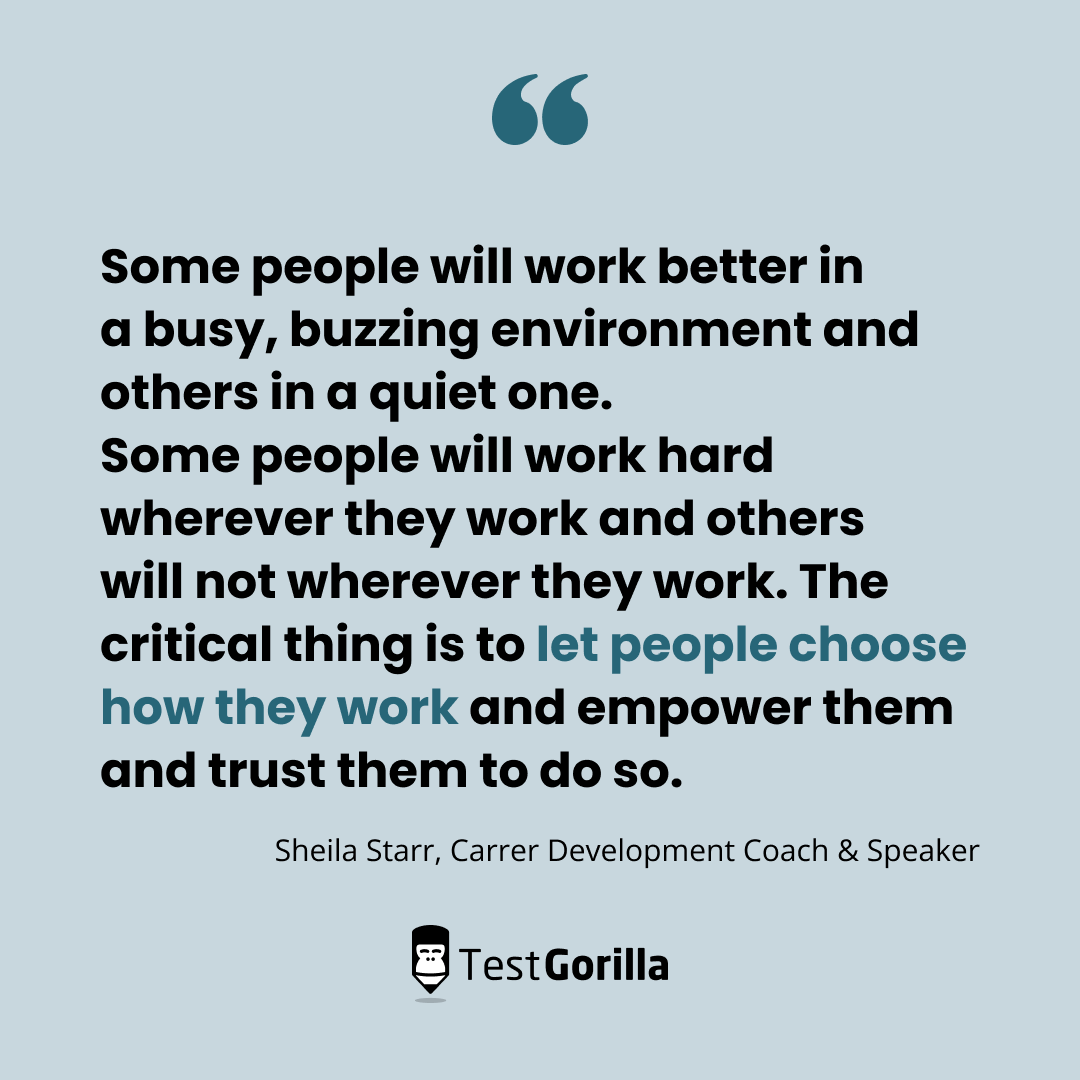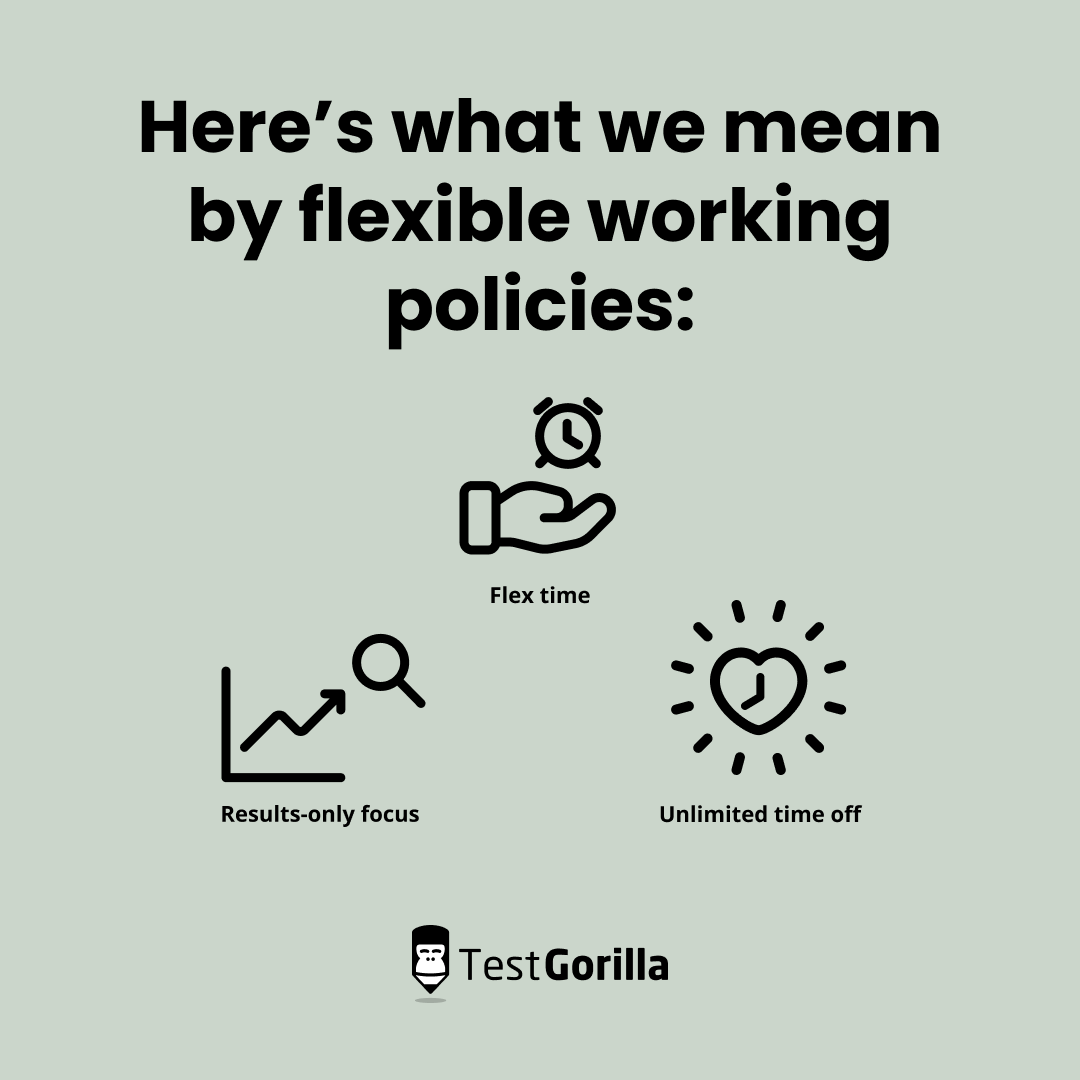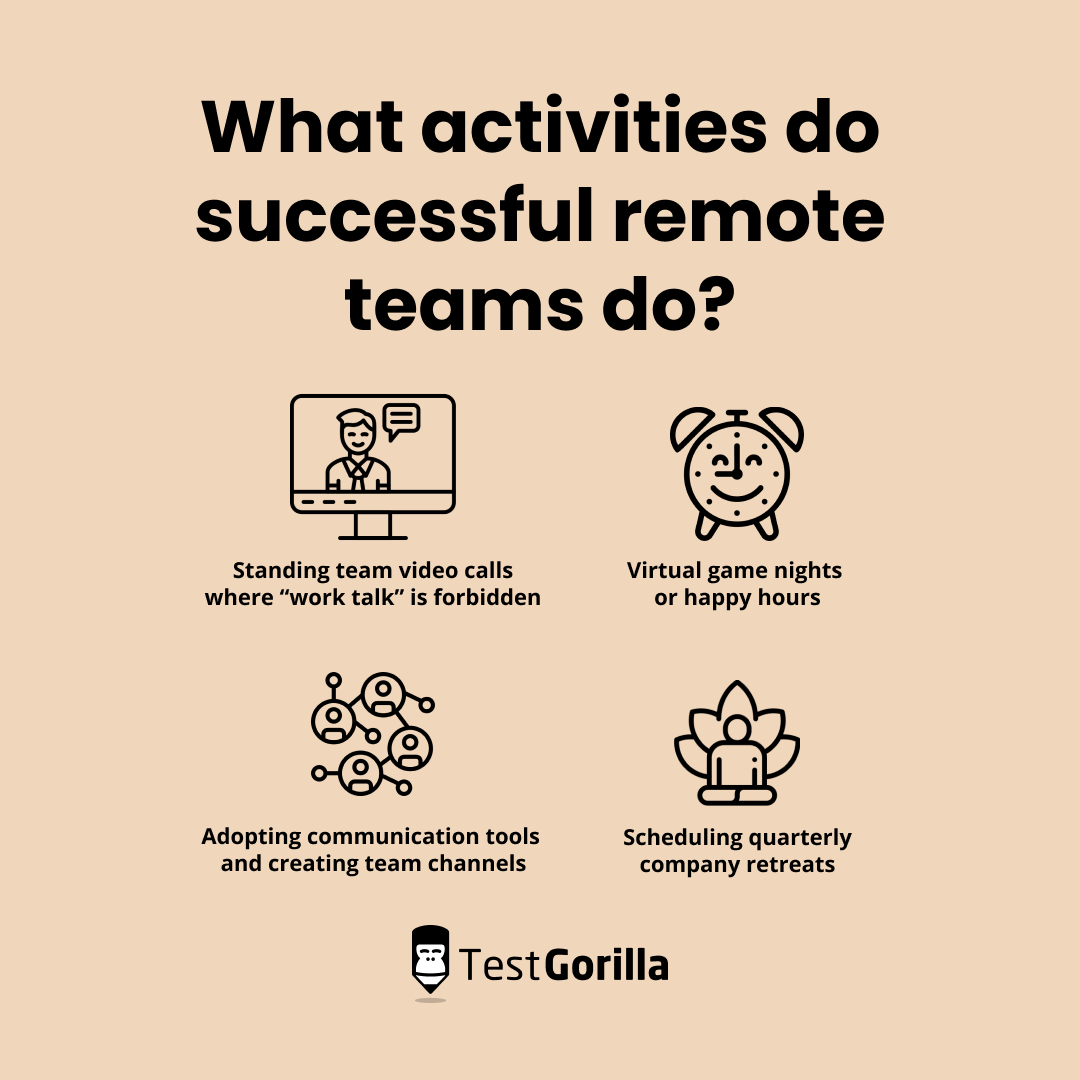As the world grappled with Covid-19, many companies adapted by shifting their work environments to fully remote or hybrid work structures.
At the time, this was a matter of public health and safety rather than a question of optimal working conditions.
Now that things are returning to normal, employers and employees alike are asking themselves – Is working from home successful for us?
On one side of the table, some managers worry about the loss of office culture and productivity, while on the other, many employees argue a flexible environment lets them do their best work.
Creating the right workplace policies in a post-Covid world is not a simple exercise for corporations or HR departments looking to balance the demands of top candidates with company goals.
However, this decision doesn’t need to be made in a vacuum. There’s a wealth of information to be gleaned from workplace research and employer experiences in the past few years.
We put together this article to settle the score and help employers determine whether work-from-home policies are a viable and productive permanent solution moving forward or if it’s time to call people back to the office once and for all.
We also share TestGorilla’s own perspective as an employer that specializes in sourcing incredible talent through skills-based testing and what we’ve done to adapt.
With that said, let’s dive in.
Table of contents
- What is work from home productivity?
- Work from home productivity: What does the research say?
- So, why is remote work making us paranoid?
- 4 bad choices managers and HR professionals can make
- 8 good choices managers and HR professionals can make
- 3 examples of work-from-home productivity
- Make work-from-home productivity a concern of the past
What is work from home productivity?
Work-from-home productivity refers to the level of efficiency or output that employees achieve while working from home or from remote locations compared to the effectiveness of working in a traditional office setting.
The core question of remote work productivity is whether the advent of new technologies and communication methods enables remote workers to be just as (or more) productive than their in-office counterparts.
This is an important debate many employers are contending with today. Both sides have loud voices that passionately argue about what the future of the work experience should look like.
Before coming to a conclusion, let’s look at what some of the most recent and compelling research says on the matter.
Work from home productivity: What does the research say?
The past few years of remote work gave researchers unique insights into the productivity of flexible workplace environments compared to office work prior to the pandemic.
With a clear control group (pre-pandemic), they were able to investigate how work-from-home policies shifted progress for the better or worse.
We asked the sharpest minds at TestGorilla to scour the landscape and pick out some eye-opening takeaways from workplace research in the preceding years to help come to a conclusion on how much productive work can really be done while remaining at home.
Here are the most surprising statistics they found about work-from-home productivity:
Highly skilled and highly educated positions are best suited for remote work environments with more than three-quarters of activities able to be done without a loss of worker productivity
Technological advancements in the workplace during the pandemic led to more productivity gains in home office settings versus office settings
Flexible policies that allow “work from anywhere” resulted in a 4.4% increase in employee output even compared against work from home policies
Companies surveyed throughout the pandemic reported that work-from-home experiences were better than expected, with researchers estimating a 4.6% increase in productivity gains in work-from-home settings
Overall, employer experience during the pandemic suggests that work from home policies actually boost productivity when compared to in-person environments.
This is especially true for employers that rely on skilled and educated knowledge workers in industries as diverse as finance, education, and IT.
But it’s not just employers demonstrating that work-from-home policies are beneficial in the modern workplace.
Workers are in agreement too, with more than 90% of employees working from home at the same or higher productivity levels.
As to why employees cite being more productive in a home office environment? There are a few consistent themes:
Flexible work policies empower workers to choose which environment best suits their needs, including options to work from public places such as coffee shops or libraries in addition to the home
Employees no longer waste enormous amounts of time commuting in traffic and can replace travel time with more productive activities
Increased flexibility and autonomy results in more motivated and happier employees
Given that workplace productivity remained consistent or even improved in a remote work world, it’s no surprise that many forward-thinking companies are adopting work-from-home policies on a permanent basis.
Some companies, however, are still hesitant to make the shift. Let’s consider why this might be for a moment.
So, why is remote work making us paranoid?
If research suggests remote work benefits productivity, why are many managers and executives concerned about the trend continuing?
“Productivity paranoia” seems to be hard to break even at the most innovative companies.
For example, in a recent survey, Microsoft reported that 80% of their managers thought their reports were less effective working from home. This is despite the vast majority of workers saying the exact opposite.
Conflicting expectations like this should be a concern for every employer considering that an unreasonable focus on productivity can lead to overworked employees, burnout, and mental health issues.
To overcome the bias toward a traditional office environment, leaders need to learn how to cultivate company culture in a digital world while also adopting technologies and processes that build high-performing teams regardless of location.
Poor management choices while navigating the shift to work-from-home policies can upset your best talent and damage the productivity you’re worried about preserving.
4 bad choices managers and HR professionals can make
Whether your company is accepting remote work with open arms or still learning to adapt to a new normal, there are some common mistakes every leader should try to avoid.
Here are four pitfalls your organization should watch out for while changing or enforcing work-from-home policies:
Forcing workers back into the office when it’s not necessary
Implementing employee surveillance tactics
Limiting the hiring pool based on location
Not focusing on interpersonal interactions
After covering what not to do in this section, we’ll include what you should do instead.
1. Forcing workers back into the office when it’s not necessary
Abruptly changing work policies and requiring a return to office without engaging your workforce first is bound to ruffle some feathers.
In fact, it might be a surefire way to lose your best talent when many employees would choose to look for a new job or quit if asked to comply with full-time in-person work.
Employees know what environments work best for them.
If your workforce is still producing the high-quality output you expect, returning to the office only removes the flexibility and autonomy that your workers value highly.
2. Implementing employee surveillance tactics
In recent years, a number of surveillance apps and tools have come to market purporting to help employers keep track of employee productivity.
This includes tactics to monitor computer activity using indications of mouse movements, keyboard actions, or internet usage.
The upside of these tools is questionable when you’re testing and hiring skilled workers in the first place.
The downsides, on the other hand, are numerous, such as when surveillance tools:
Invade employee privacy
Damage employee trust
Increase distractions
Lack context about what matters
After all, if the data savant at your company listens to YouTube in the background while productively crunching numbers, should you really care?
3. Limiting the hiring pool based on location
Employers that adopt a remote-first work environment benefit from a global (or at least national) workforce.
This means they are able to hire the best possible candidate for a position rather than the best candidate within a short commute from the office.
The requirement to only assess local applicants limits the pool of potential candidates drastically.
Furthermore, as remote work becomes more desired by employees, the most talented will limit their own search to companies that have flexible work policies.
Winning the talent war may simply be harder for employers that require in-person work.
Of course, there are sometimes limitations to geographically expanding your talent pool. For example, most medical and legal professionals can only engage with clients within states that they’re licensed in, even when they’re meeting remotely.
Be sure to always check the legal implications in your field before expanding your applicant pool beyond your local area.
4. Not focusing on interpersonal interactions
Whether teams at your company work together in the same office or collaborate virtually from different corners of the Earth, effective teamwork requires authentic connections.
Managers of remote teams commonly forget to place enough emphasis on the interpersonal relationships formed between coworkers.
Ensuring a team creates bonds is more difficult in a virtual environment and therefore requires extra planning and intention.
Relationships between managers and their teams can also become strained if the only time they interact is during direct feedback or instruction. Engaging remote employees with frequent and informal check-ins is necessary but doesn’t always happen organically.
Lastly, it’s easier to communicate in ways that lack empathy in virtual situations. It’s hard to interpret non-verbal cues or tone in instant messages or emails.
Managers of virtual work environments need to be extra careful to ensure employees aren’t unintentionally offended or misunderstood.
8 good choices managers and HR professionals can make
With the bad choices out of the way, let’s address what the best companies are doing to maintain excellent productivity while respecting employee demand for remote and hybrid work environments.
A summary of the best practices to consider
Here are some good choices leaders make at companies that have adopted flexible work policies successfully:
Embrace work from home across your organization
Make hybrid the default
Build flexible working policies
Invest in company culture
Gain confidence with skills-based hiring
Invest in technology for remote success
Provide support for issues outside work
Allow for asynchronous communication
Let’s look at each in detail.
1. Embrace work from home across your organization
Some businesses may find it difficult to embrace doing work at home for certain roles that require in-person work like healthcare or retail sales.
However, for the vast majority of companies that employ highly skilled workers, most work can be done effectively via a laptop and internet connection.
For businesses like this, it’s best practice to adopt work-from-home policies consistently across the organization.
Not only does this send the positive message that your company treats everyone equally, but it also ensures that remote processes get adopted seamlessly because everyone is on the same footing.
2. Make hybrid the default
For those businesses that have a mixture of work that can be done remotely and also work that necessitates in-person attendance, making hybrid the default option is a good way to straddle the middle ground.
Hybrid office models give employees the benefit of the option to work from the office space or facility when it’s required or when they desire to do so, but they have the added flexibility to work remotely when it’s appropriate.
Hybrid work environments are on the rise primarily because talented employees are demanding it.
To put it in perspective, one study reported that 87% of workers would take advantage of remote work if given the choice and would spend an average of 3 days per week working from home.
A hybrid-first model is a great choice to attract talented candidates while also giving your organization the flexibility it needs for certain responsibilities to be done in person.
3. Build flexible working policies for each role and department
Flexible working policies cover more than just considerations about remote work vs office productivity.
Here’s what we mean by flexible working policies:
Flexible policy example | What it means |
Flex time | Employees work a set number of hours but can work according to their own schedule. For example, they could work outside the normal 9-5 hours or compress their responsibilities into 4 days each week instead of 5. |
Results-only focus | Some companies may drop a focus on working hours altogether and instead focus on rewarding work that is well done regardless of how long it takes. |
Unlimited time off | Rather than providing a predetermined number of vacation days, sick days, and personal days, it’s left to each employee to take the time when they need it. |
Remote work naturally fits with other flexible work policies because they put responsibility and trust in the hands of employees and create a productive workplace that focuses on what work gets done rather than how it gets done.
4. Invest in company culture
Investing in company culture is important for every business, but it’s especially acute in remote work settings.
That’s because it can be difficult to build a cohesive company culture in a virtual environment.
It’s harder for employees to build organic relationships with coworkers when they don’t see them in the hallways or during lunch breaks.
Besides hiring for great culture additions in the first place, remote companies are also learning to adopt technologies and communication platforms that make culture-building easy in a virtual world.
What are some activities we’re seeing successful remote teams do?
Standing team video calls where “work talk” is forbidden
Virtual game nights or happy hours
Adopting communication tools and creating team channels
Scheduling quarterly company retreats (yes, this one can be in person)
If your company builds a culture of performance and trust, remote work productivity won’t be a concern.
5. Let skills-based hiring give you confidence
A central concern about work-from-home productivity is whether employers can trust employees to accomplish what needs to get done without oversight and in-person feedback.
But what if you had full confidence that your workers were capable and eager to do their best work possible?
The key to recruiting talented employees that don’t need tracking or micromanaging starts and ends with effective hiring practices.
That’s why TestGorilla is on a mission to help employers hire candidates they can rely on to be productive in any work environment through pre-employment skills testing.
Skills-based hiring relies on an objective assessment of each applicant’s capabilities rather than subjective reviews of their past experience.
This leads to hires that can be trusted to hit the ground running from day one, regardless of their work location.
6. Invest in technology for remote success
Tools like Zoom, Slack, or Trello can be helpful for any business but are especially important for remote teams.
Technologies like these help team members communicate on different timeframes and build personal connections even if employees aren’t meeting face-to-face.
This helps teams stay productive and build an effective culture.
Another best practice is to provide employees with a remote tech budget to set up a productive workspace in their homes.
This is something we do at TestGorilla for our own employees. We’ve seen the productivity benefits when employees have comfortable work environments and the proper tools to handle responsibilities.
7. Provide support for issues apart from work
Employees that work from home inherently have fewer personal interactions during their work day.
While some types of people may appreciate this, others are likely to find the lack of social life at work difficult.
It’s important for remote or hybrid teams to invest extra time and attention into their employees’ health outside of work.
This can be accomplished formally with mental health benefits and programs and informally by creating a culture that cares about the social well-being of the workforce.
The mental and emotional health of your workers matters in any business, but teams that work from home may face unique challenges.
8. Allow for asynchronous communication
Remote and hybrid teams are likely to work in different time zones with different normal working hours.
This means that interactions may be delayed by coworkers or that parts of projects need to be handed off overnight.
Expecting some amount of asynchronous communication is good practice for teams that work from home. Encouraging it can help team members that work during different hours not feel like they have to be on-call day and night.
Setting the precedent that emails and Slack messages shouldn’t receive an immediate response if they are sent outside of an individual’s workday creates a healthier work environment.
3 examples of work-from-home productivity
If your company is searching for inspiration from other progressive companies thriving in remote and hybrid work environments, look no further.
Let’s look at three companies maintaining high productivity and an effective work culture while still promoting work from home for their employees.
Company | Work from home policies | Rationale and response |
TestGorilla (that’s us!) | A global workforce from dozens of countries around the world; 100% remote structure regardless of role; Skills-based hiring practices that emphasize fair assessments of abilities over biased assessments of experience; Tech budgets for employees to create productive workspaces at home | At TestGorilla, we eat our own cooking and hire according to the skills-based practices we espouse. By focusing on skills, we’re able to source the best talent for our company from around the world. We also find that a fully remote structure creates an even playing field for each employee and engenders a collaborative culture. |
“Digital by default” remote-first work policy; Technology stipends for employees to buy equipment and tools to work effectively from home; Increased investment in digital technologies and communication platforms; Virtual mental health support programs | In May 2020, Shopify announced their remote work policy driven by the belief that “work is not where you are, but what you get done.” Employees note better work-life balance and increased autonomy but benefits also accrue to the company. Shopify has since reported increased productivity and is proud of the environmental impacts of reducing commuting emissions across its workforce. | |
Remote working policies depending on the role that allows for majority in-office, majority at-home, or flexible work; Benefits and perks that are location-agnostic; Remote-first roles are the default option; Virtual team-building events, onboarding programs, and training | HubSpot committed to moving from a remote-friendly to a remote-first company in 2020. Besides Covid-19, the rationale for the shift was that the company recognized that “results matter more than when or where they’re produced.” The company has also since commented on the benefits of diversifying its candidate pool and finding talent in new places that were historically overlooked when hiring for in-person positions. |
All of these examples prove that working from home doesn’t just work for employees but also works for employers to build a productive and engaged workforce.
Make work-from-home productivity a concern of the past
From personal experience and a keen reading of the latest workplace research, we’ve concluded that remote and hybrid work structures can be just as productive as office work environments.
Forward-thinking companies can adopt tools, processes, and attitudes that make the transition to remote policies straightforward.
That’s a relief for employers that want to be competitive in attracting the best talent – candidates overwhelmingly value flexible working arrangements highly.
For those organizations that are still concerned about retaining productivity when employees work from home, skills-based hiring practices can make those worries a thing of the past.
Employers can focus on reskilling and upskilling their existing workforce to succeed in a remote environment. And when it’s time, they can make confident hiring choices whether they’re looking for a remote email marketer or a hybrid SQL analyst.
For any other workplace worries, check out some of our other helpful articles:
To find out more about how TestGorilla can help you find the right remote workers with skills testing, sign up for your free account or book your free 30-minute live demo with a member of our sales team.
Related posts
Hire the best candidates with TestGorilla
Create pre-employment assessments in minutes to screen candidates, save time, and hire the best talent.
Latest posts
The best advice in pre-employment testing, in your inbox.
No spam. Unsubscribe at any time.

Hire the best. No bias. No stress.
Our screening tests identify the best candidates and make your hiring decisions faster, easier, and bias-free.
Free resources
This checklist covers key features you should look for when choosing a skills testing platform
This resource will help you develop an onboarding checklist for new hires.
How to assess your candidates' attention to detail.
Learn how to get human resources certified through HRCI or SHRM.
Learn how you can improve the level of talent at your company.
Learn how CapitalT reduced hiring bias with online skills assessments.
Learn how to make the resume process more efficient and more effective.
Improve your hiring strategy with these 7 critical recruitment metrics.
Learn how Sukhi decreased time spent reviewing resumes by 83%!
Hire more efficiently with these hacks that 99% of recruiters aren't using.
Make a business case for diversity and inclusion initiatives with this data.






















